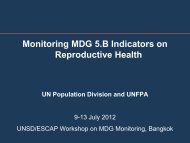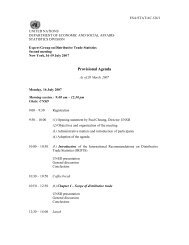demographic yearbook annuaire demographique 1951
demographic yearbook annuaire demographique 1951
demographic yearbook annuaire demographique 1951
You also want an ePaper? Increase the reach of your titles
YUMPU automatically turns print PDFs into web optimized ePapers that Google loves.
tions than do conventional central death rates such as<br />
those shown in table 17.<br />
Table 27 presents life table mortality rates. This rate<br />
represents the probability of dying during a given age<br />
interval, usually one year. It is the basic function of the<br />
life table and is commonly indicated by the symbol qx, the<br />
subscript referring to the age and values for specific ages<br />
being written q0 for "under 1", q1 for age 1 etc. The values<br />
shown in table 27 are expressed as 7,000 qx and represent the<br />
number dying per 1,000 persons reaching age x or the<br />
probability per 1,000 of dying within one year after reaching<br />
age x.<br />
The life table mortality rate differs from the central<br />
death rate in that it refers to persons reaching the given<br />
age during the course of a year rather than to persons of<br />
that age at the middle of the year. Thus the rates are<br />
similar in concept to the infant mortality rates shown in<br />
table 19. But the life table mortality rate for persons under<br />
1 year of age usually differs from the type of infant mortality<br />
rate shown in table 19 through being so adjusted<br />
that infant deaths are related to the cohort of births among<br />
which they occurred.<br />
The complete life table gives values for each single year<br />
of age. Most of the data presented in table 27 are of this<br />
type. An abridged life table gives values for grouped ages,<br />
usually 5-year age groups. Some of the data in table 27<br />
are of the latter type and are so noted. In these cases, the<br />
mortality rate is the probability of dying, not within one<br />
year after reaching the age indicated, but within 5 years<br />
of that age (or within the specified number of years).<br />
Details of procedure in life table construction vary somewhat,<br />
depending in large measure upon the availability<br />
and form of basic data. The values of qx are generally so<br />
derived as to correspond to the death rates of persons of<br />
that age in a particular period of time. The basic data<br />
ordinarily consist of (a) deaths in a given period classified<br />
by age and sex and (b) the mean population of each age<br />
and sex during that period. The most usual procedure is<br />
to utilize statistics of deaths in a three-year or five-year<br />
period centered at the census date so that the census figures<br />
can be taken as the mean population. Sometimes the period<br />
covered is that between two censuses and the population<br />
figures utilized are averages of the results of the two<br />
censuses. A correction for the effect of migration is occasionally<br />
made. In a few rare cases (for example, in India)<br />
approximate life tables have been computed without the<br />
use of data on deaths by deriving qx values from the comparison<br />
of the population in an age group as enumerated<br />
at one census with the survivors at the next census. It is<br />
common to make adjustments in order to correct for misstatements<br />
of age in the census and death registration data<br />
and in order to obtain successive values of qx which vary<br />
smoothly from one age to the next.<br />
Special problems arise in deriving qx values for the very<br />
young ages and for the end of life. For the young ages qx<br />
values are frequently obtained by using the statistics of<br />
births occurring in the last few years and estimating from<br />
them the number of persons at risk of dying in the period<br />
to which the life table relates. At the older ages data are<br />
frequently so scanty or unreliable that they have to be<br />
subjected to considerable manipulation if a reasonable<br />
series of qx values is to be derived from them. In many<br />
cases the life table qx values at the high ages do not depend<br />
in any wayan the registered deaths at those ages, but have<br />
been estimated on the basis of qx figures for younger ages.<br />
Table 28 gives Ix values from the same life tables as those<br />
shown in table 27. These figures were derived from the qx<br />
values and represent the number surviving to each age<br />
among 100,000 born alive and subjected thereafter to the<br />
mortality rates of the given life table. In other words, they<br />
are the probabilities, per 100,000, of surviving from birth<br />
to the exact age specified.<br />
Table 29 gives the "expectation of life" (ex) or the average<br />
number of years of life remaining for persons reaching<br />
the specified ages. These data are also based on the mortality<br />
rates of the life table and are to be interpreted strictly<br />
in terms of the underlying assumption that surviving cohorts<br />
are subjected to the age-specific mortality rates of the<br />
period to which the life table refers. Thus, in interpreting<br />
~:50 in the 1931-1941 life table for Switzerland, it may be<br />
said that, if males reaching age 50 were to experience for<br />
the rest of their lives the same age-specific mortality rates<br />
that obtained during the period 1931-1941, they would, on<br />
the average, live 21.3 years past the age of 50.<br />
The life table, though first developed for actuarial purposes,<br />
has many applications in the <strong>demographic</strong> field.<br />
Among these are: (1) the preparation of population projections<br />
by age and sex; (2) analysis of effects of mortality<br />
on the age and sex composition of a population; (3) comparisons<br />
of summarizing measures of mortality, as the life<br />
table death rate (the reciprocal of the expectation of life<br />
and birth), expectation of life at various ages etc.; (4) computation<br />
of net reproduction rates; and (5) the appraisal<br />
of the accuracy of census enumerations and vital registration<br />
data. In addition, life table techniques have been<br />
applied to the analysis of other types of <strong>demographic</strong> data,<br />
for example, in the computation of probabilities of marriage,<br />
specific for age and sex, on the basis of census data classified<br />
by marital status.<br />
The majority of life tables, and all those contained in<br />
this Yearbook, are based on qx values obtained from the<br />
deaths of persons of different ages occurring in the same<br />
period. Thus, they do not represent the actual mortality<br />
experience of anyone generation. Where the necessary<br />
statistics of population and deaths are available over long<br />
periods of time it is possible to calculate qx values representing<br />
the experience of a group or persons born in a<br />
specified period and traced throughout life. For example,<br />
a life table can be computed using for qo the infant mortality<br />
of 1880, for q1 a value derived from the deaths of<br />
infants aged one in 1881, for q2 a figure based on the deaths<br />
of children aged two in 1882 and so on. Such "generation"<br />
life tables may differ significantly from conventional tables<br />
in countries where mortality rates have been changing<br />
rapidly. However, not many such tables have been calculated<br />
and for most countries the required statistics are not<br />
available.<br />
The accuracy of life tables depends mainly upon the<br />
accuracy and completeness of the registration of deaths<br />
and of the enumeration of the population at the census.<br />
Deficiencies in death registration are likely to be greater<br />
than in census enumeration. Where this happens death<br />
rates are understated and the Ix and ex values are exaggerated.<br />
The mortality rates computed from population<br />
and death statistics at the very young ages are particularly<br />
likely to be understated, and such an error affects the Ix<br />
values throughout the table. As indicated earlier, infant<br />
mortality rates obtained by relating the number of infant<br />
deaths to the number of births in countries where registration<br />
is deficient may be either too low or too high, and the<br />
37













